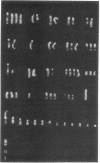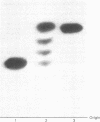Abstract
Fourteen hybrid clones derived from the fused cultures of human lymphoblastoid FV5 cells and 5-bromodeoxyuridine-resistant mouse fibroblastic MCB2 cells grown in hypoxanthine/aminopterin/thymidine selective medium were examined for the presence of Epstein-Barr virus (EBV) DNA, the expression of the virus-determined nuclear antigen (EBNA), and the presence of human chromosomes, in the course of serial passage in vitro. Among the hybrid clones tested, 3 were positive for EBV DNA and EBNA, whereas the remaining 11 were totally negative. The chromosome investigations showed that human chromosome 14 was consistently involved in all three EBV genome-positive and EBNA-positive hybrid clones, but not in any negative clones. In 10 subclones isolated from 1 of the 3 positive clones, all of which contained only chromosome 14 of the human chromosomes, a concordant segregation of EBNA, EBA DNA, and chromosome 14 was evident. These findings suggest that the resident EBV genome is closely associated with chromosome 14 and the presence of this particular chromosome alone is sufficient for the maintenance and the expression of EBV genetic information in human lymphoblastoid cells.
Full text
PDF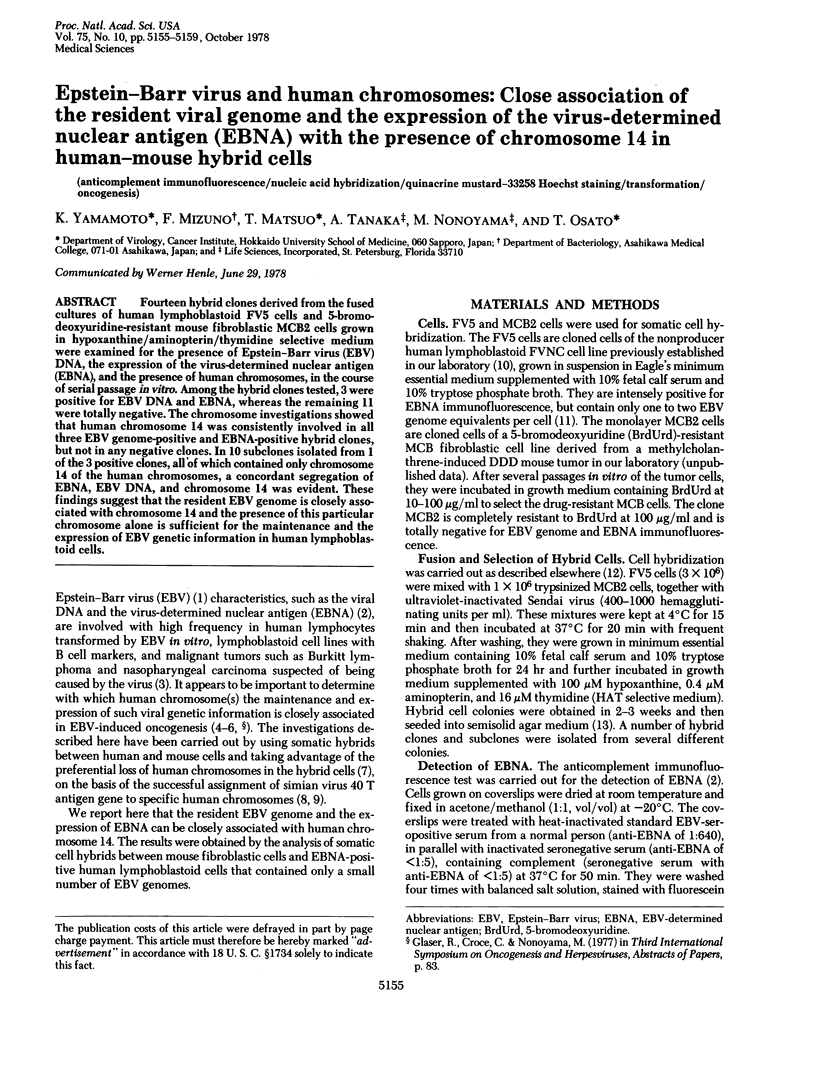
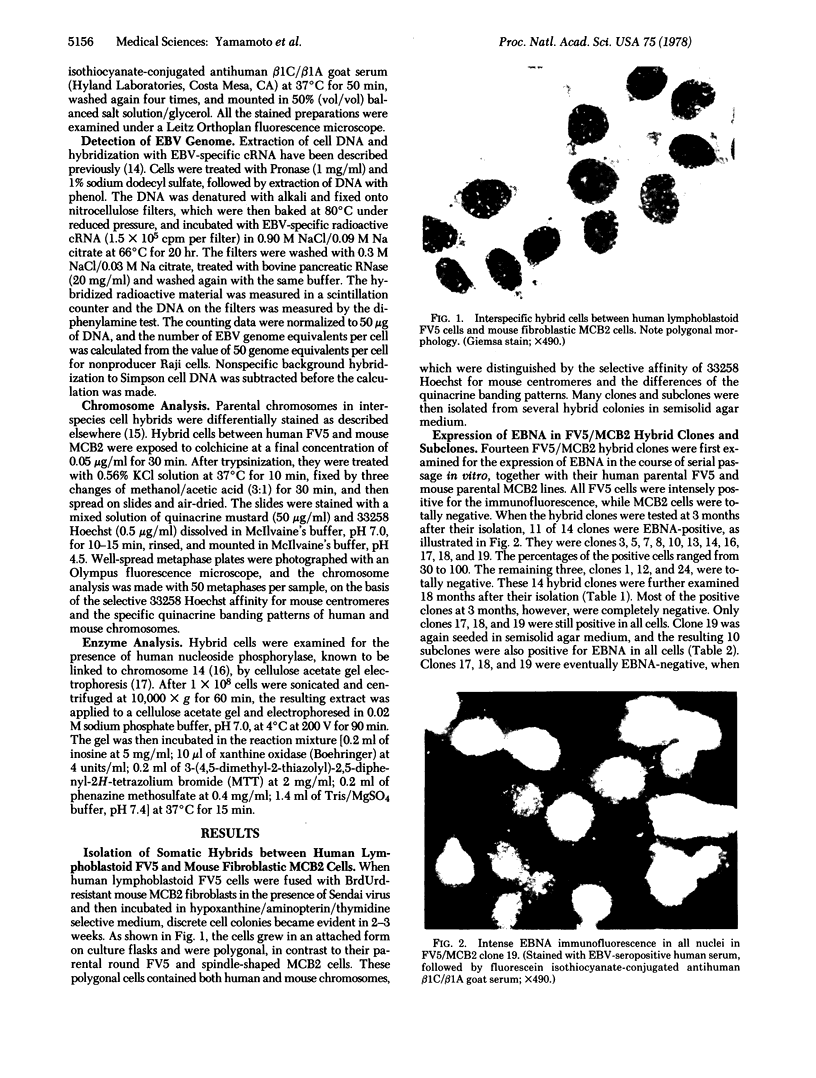
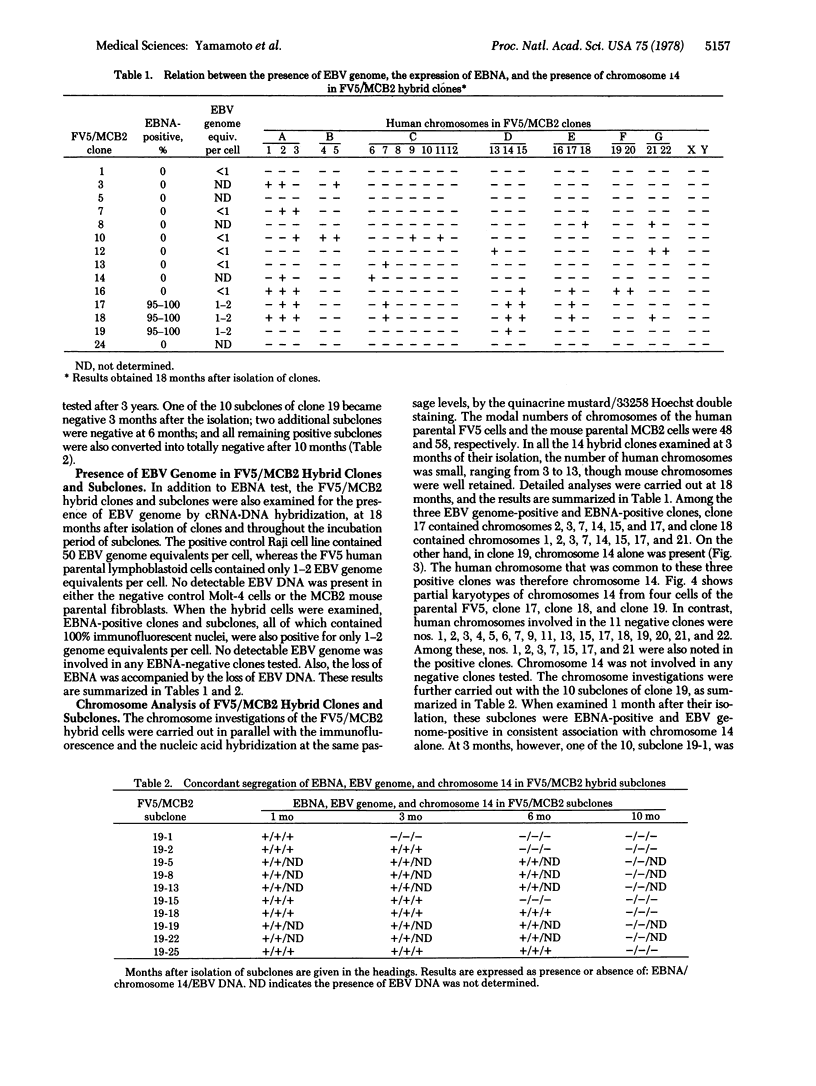
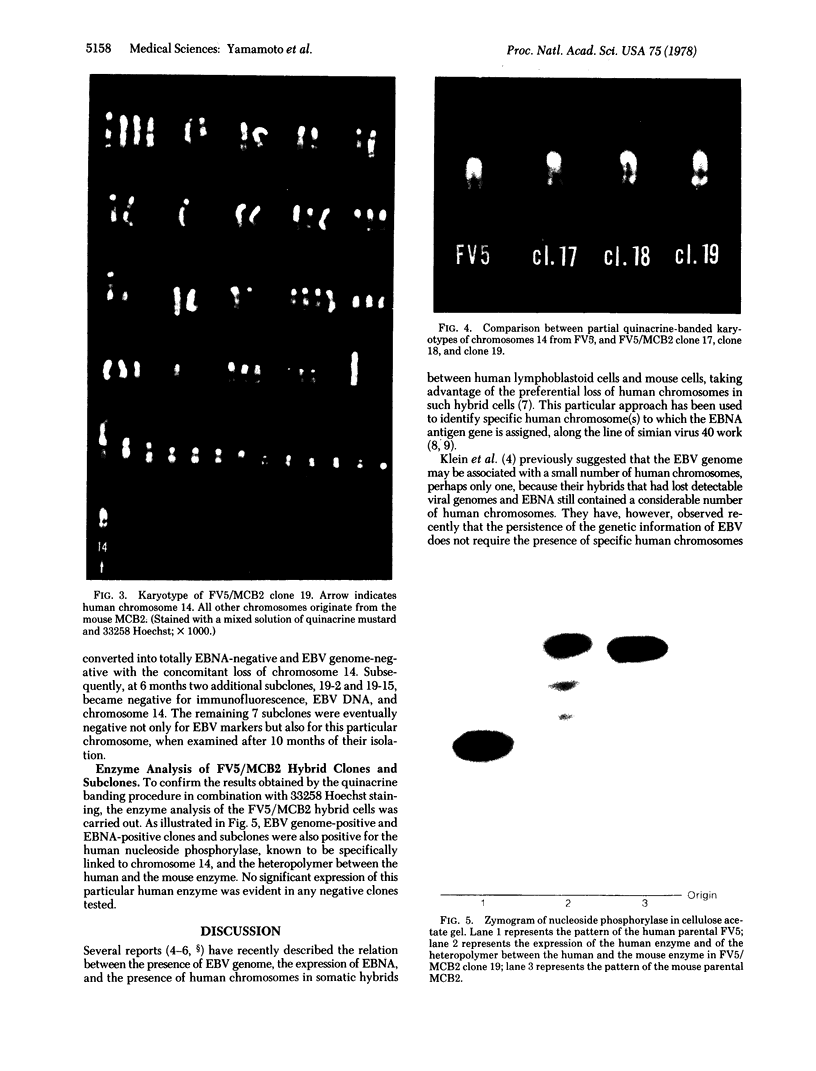

Images in this article
Selected References
These references are in PubMed. This may not be the complete list of references from this article.
- Croce C. M. Assignment of the integration site for simian virus 40 to chromosome 17 in GM54VA, a human cell line transformed by simian virus 40. Proc Natl Acad Sci U S A. 1977 Jan;74(1):315–318. doi: 10.1073/pnas.74.1.315. [DOI] [PMC free article] [PubMed] [Google Scholar]
- Croce C. M., Girardi A. J., Koprowski H. Assignment of the T-antigen gene of simian virus 40 to human chromosome C-7. Proc Natl Acad Sci U S A. 1973 Dec;70(12):3617–3620. doi: 10.1073/pnas.70.12.3617. [DOI] [PMC free article] [PubMed] [Google Scholar]
- EPSTEIN M. A., ACHONG B. G., BARR Y. M. VIRUS PARTICLES IN CULTURED LYMPHOBLASTS FROM BURKITT'S LYMPHOMA. Lancet. 1964 Mar 28;1(7335):702–703. doi: 10.1016/s0140-6736(64)91524-7. [DOI] [PubMed] [Google Scholar]
- Glaser R., Nonoyama M., Shows T. B., Henle G., Henle W. Epstein-Barr virus: studies on the association of virus genome with human chromosomes in hybrid cells. IARC Sci Publ. 1975;(11 Pt 1):457–466. [PubMed] [Google Scholar]
- HARRIS H., WATKINS J. F. HYBRID CELLS DERIVED FROM MOUSE AND MAN: ARTIFICIAL HETEROKARYONS OF MAMMALIAN CELLS FROM DIFFERENT SPECIES. Nature. 1965 Feb 13;205:640–646. doi: 10.1038/205640a0. [DOI] [PubMed] [Google Scholar]
- Jarvis J. E., Ball G., Rickison A. B., Epstein M. A. Cytogenetic studies on human lymphoblastoid cell lines from Burkitt's lymphomas and other sources. Int J Cancer. 1974 Dec 15;14(6):716–721. doi: 10.1002/ijc.2910140604. [DOI] [PubMed] [Google Scholar]
- Klein G., Wiener F., Zech L., zur Hausen H., Reedman B. Segregation of the EBV-determined nuclear antigen (EBNA) in somatic cell hybrids derived from the fusion of a mouse fibroblast and a human Burkitt lymphoma line. Int J Cancer. 1974 Jul 15;14(1):54–64. doi: 10.1002/ijc.2910140108. [DOI] [PubMed] [Google Scholar]
- Manolov G., Manolova Y. Marker band in one chromosome 14 from Burkitt lymphomas. Nature. 1972 May 5;237(5349):33–34. doi: 10.1038/237033a0. [DOI] [PubMed] [Google Scholar]
- Mizuno F., Aya T., Osato T. Growth in semisolid agar medium of human cord leukocytes freshly transformed by Epstein-Barr virus. J Natl Cancer Inst. 1976 Jan;56(1):171–173. doi: 10.1093/jnci/56.1.171. [DOI] [PubMed] [Google Scholar]
- Nonoyama M., Pagano J. S. Detection of Epstein-Barr viral genome in nonproductive cells. Nat New Biol. 1971 Sep 22;233(38):103–106. doi: 10.1038/newbio233103a0. [DOI] [PubMed] [Google Scholar]
- Reedman B. M., Klein G. Cellular localization of an Epstein-Barr virus (EBV)-associated complement-fixing antigen in producer and non-producer lymphoblastoid cell lines. Int J Cancer. 1973 May;11(3):499–520. doi: 10.1002/ijc.2910110302. [DOI] [PubMed] [Google Scholar]
- Ricciuti F., Ruddle F. H. Assignment of nucleoside phosphorylase to D-14 and localization of X-linked loci in man by somatic cell genetics. Nat New Biol. 1973 Feb 7;241(110):180–182. doi: 10.1038/newbio241180a0. [DOI] [PubMed] [Google Scholar]
- Spira J., Povey S., Wiener F., Klein G., Andersson-Anvret M. Chromosome banding, isoenzyme studies and determination of Epstein-Barr virus DNA content on human Burkitt lymphoma/mouse hybrids. Int J Cancer. 1977 Dec 15;20(6):849–853. doi: 10.1002/ijc.2910200605. [DOI] [PubMed] [Google Scholar]
- Weiss M. C., Green H. Human-mouse hybrid cell lines containing partial complements of human chromosomes and functioning human genes. Proc Natl Acad Sci U S A. 1967 Sep;58(3):1104–1111. doi: 10.1073/pnas.58.3.1104. [DOI] [PMC free article] [PubMed] [Google Scholar]
- Zech L., Haglund U., Nilsson K., Klein G. Characteristic chromosomal abnormalities in biopsies and lymphoid-cell lines from patients with Burkitt and non-Burkitt lymphomas. Int J Cancer. 1976 Jan 15;17(1):47–56. doi: 10.1002/ijc.2910170108. [DOI] [PubMed] [Google Scholar]
- van Someren H., Beijersbergen van Henegouwen H., Los W., Wurzer-Figurelli E., Doppert B., Vervloet M., Meera Khan P. Enzyme electrophoresis on cellulose acetate gel. II. Zymogram patterns in man-Chinese hamster somatic cell hybrids. Humangenetik. 1974;25(3):189–201. doi: 10.1007/BF00281426. [DOI] [PubMed] [Google Scholar]





